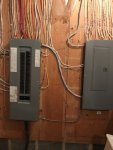I noticed there is a lot of knowledge on generators on this website. I have a 200 amp panel in my house. I may have a chance to acquire a 5,000 watt Honda portable generator. That works out to almost 50 amps. The wiring from outside to the panel inside is already in place. I need to get a legal transfer switch and outdoor receptacle wired in. Do I need a 200 amp transfer switch or is the amperage specified by the generator amperage? Thanks.
You are using an out of date browser. It may not display this or other websites correctly.
You should upgrade or use an alternative browser.
You should upgrade or use an alternative browser.
Generator Transfer Switch Amperage rating
- Thread starter Snagglefoot
- Start date
MolaKule
Staff member
P = I X V; so I = 5000Watts/240V = 21 Amps so you would need a 30A transfer switch.
Yea, my generator outputs 30 amps so I'm using a 50 amp switch.
How do you intend to disconnect from the utility when the generator is powering the load? More information is needed for a proper response here. If you are talking a double throw manual transfer switch that will break the utility connection to your panel and connect the generator, the switch and wiring will need to match the 200A rating of the panel.
Depends on the kind of transfer switch you're looking at. If you're looking at one that transfers some of the circuits, a 30 amp would be fine. Not sure how you're getting 50 amps from a 5,000 watt generator. Typically those have 2 120V legs, or 2,500 watts on each leg. That would work out to about 20.83 amps maximum per leg. A 30 amp transfer switch should be fine.
Snagglefoot
Thread starter
Yes, I am looking to break the utility connection and connect to the generator manually. It’s code here that it has to be done with a single device. So does that mean it’s rated for 200 amps? The highest amp rating I have seen so far is 100 amps.How do you intend to disconnect from the utility when the generator is powering the load? More information is needed for a proper response here. If you are talking a double throw manual transfer switch that will break the utility connection to your panel and connect the generator, the switch and wiring will need to match the 200A rating of the panel.
Last edited:
Snagglefoot
Thread starter
Yes, there is some question on how these devices are rated. Is it just the amperage of one 120 V leg or the total of the two legs.? Also this device has to be capable of shutting off the main power which is 200 amps.Depends on the kind of transfer switch you're looking at. If you're looking at one that transfers some of the circuits, a 30 amp would be fine. Not sure how you're getting 50 amps from a 5,000 watt generator. Typically those have 2 120V legs, or 2,500 watts on each leg. That would work out to about 20.83 amps maximum per leg. A 30 amp transfer switch should be fine.
Sounds like you will need a double throw transfer switch rated at 200 amps. You will need to use 2/0 wire between the panel and transfer switch. Should be able to wire the generator in with #10. Article 310 of the National Electrical Code was referenced here. I assume similar conditions apply in Canada.
He shouldn't try to supply his whole house with a 20-30 amp generator. Pick out the most important circuits in your house that are at or loaded under 30 amps total and route them to a sub-panel. Let the generator supply this sub-panel through a double pole/double throw transfer switch. This is how it was done at my house (5 circuits).
He stated he already has wire in place. This does not sound like several loads are already broken out for a multi circuit transfer switch. More info/pictures are needed. Personally I wouldn't want to be limited by those things anyway. What if i wanted lights on in a room that wasn't fed? The cost of a double throw disconnect would be similar by the time you have someone certified break out all of those circuits and wire it in.
Same here.Yea, my generator outputs 30 amps so I'm using a 50 amp switch.
True. Then he's looking at a 200 amp switch with 200 amp wiring.He stated he already has wire in place. This does not sound like several loads are already broken out for a multi circuit transfer switch. More info/pictures are needed. Personally I wouldn't want to be limited by those things anyway. What if i wanted lights on in a room that wasn't fed? The cost of a double throw disconnect would be similar by the time you have someone certified break out all of those circuits and wire it in.
You need a 6 to 8 circuit transfer switch and pick the circuits that are critical in a power failure. 220V like a water pump will take 2 circuits. Then you install the transfer switch next to your main circuit breaker box.
You do not mess with the 200 amp coming in.
If you had a huge whole house generator then you would get a 200 AMP transfer switch.
You do not mess with the 200 amp coming in.
If you had a huge whole house generator then you would get a 200 AMP transfer switch.
Yes, there is some question on how these devices are rated. Is it just the amperage of one 120 V leg or the total of the two legs.? Also this device has to be capable of shutting off the main power which is 200 amps.
It's the current of one leg. Your 200 amp service is 200 amps at 240 volts, or two 200 amp, 120 volt legs. That's how it arrives at your house.
Not really any question of how the generators are rated. 5000 watts is the maximum, although the continuous rating is usually lower. Once again, they are usually split so the limit for a single 120 volt load is half of that. Example, my 4,000 watt generator is 3,200 watts continuous, but there are two 13 amp breakers, one for each leg, so you can't power an 1800 watt heater since one circuit can only power 1600 watts (13 x 120). You can power a 3,200 watt, 240 volt load however, since the two legs provide 240 volts.
Not sure why you can't use a switch like one of these:
https://www.amazon.com/Reliance-Con...9Y2xpY2tSZWRpcmVjdCZkb05vdExvZ0NsaWNrPXRydWU=
Snagglefoot
Thread starter
It's the current of one leg. Your 200 amp service is 200 amps at 240 volts, or two 200 amp, 120 volt legs. That's how it arrives at your house.
Not really any question of how the generators are rated. 5000 watts is the maximum, although the continuous rating is usually lower. Once again, they are usually split so the limit for a single 120 volt load is half of that. Example, my 4,000 watt generator is 3,200 watts continuous, but there are two 13 amp breakers, one for each leg, so you can't power an 1800 watt heater since one circuit can only power 1600 watts (13 x 120). You can power a 3,200 watt, 240 volt load however, since the two legs provide 240 volts.
Not sure why you can't use a switch like one of these:
So in a system like the one you described, I would move 6 circuits over to the box provided and flip the switch to get power to them from the generator while cutting the power feed from the grid to those 6 circuits, correct?
Last edited:
So in a system like the one you described, I would move 6 circuits over to the box provided and flip the switch to get power to them from the generator while cutting the power feed from the grid to those 6 circuits, correct?
Correct. That way, it still functions as an interlock to prevent connecting the grid and generator simultaneously without having to remember to turn off certain loads to avoid overloading the generator. Don't know if the codes where you are take exception to it, but they meet the requirements here. They make others that have 8 or more circuits too, that was just an example.
Snagglefoot
Thread starter
I have 80 breakers, 60 on the main panels which filled it up, and 20 more on a pony panel. This was new construction from 2012. Some are double breakers. Unfortunately the various breakers of interest are dived between the two panels. The wires are easily accessible and there is room to place a generator panel. Yes, it would be nice to be able to access them all, but if was limited to 6, here is my choice:He stated he already has wire in place. This does not sound like several loads are already broken out for a multi circuit transfer switch. More info/pictures are needed. Personally I wouldn't want to be limited by those things anyway. What if i wanted lights on in a room that wasn't fed? The cost of a double throw disconnect would be similar by the time you have someone certified break out all of those circuits and wire it in.
Two for the water well pump.
One for the propane boiler circuitry and circulation pumps.
One for the furnace fan.
One for the kitchen fridge.
One for the kitchen lights, which also sheds light on the open area living room and dining table.
Thoughts?
Snagglefoot
Thread starter
Thanks for the kind attention and comments. For those still interested, here is my main panel with a 200 amp main breaker. It is totally filled with 60 breakers. Then I have the pony panel with another 20 breakers, joined by the electrical cable shown. The electrician roughed in a cable from a box outside close to where the portable generator would be parked and ran it into the basement furnace room where the panels are.








Last edited:
I can run my 2500 sq ft house on the 5500W gas generator. I do not have to run just 5 or 6 circuits. I do have to shut off the central AC. And I must configure my hybrid electric water heater to "max efficiency mode" which only runs the 600w heat pump and not the 4500w heating element.
Other than that, I can run my well pump, window AC, 2 chest freezers, fridge, computers, TV and all the LED lights I want.
Other than that, I can run my well pump, window AC, 2 chest freezers, fridge, computers, TV and all the LED lights I want.
Similar threads
- Replies
- 9
- Views
- 3K
- Replies
- 29
- Views
- 2K


